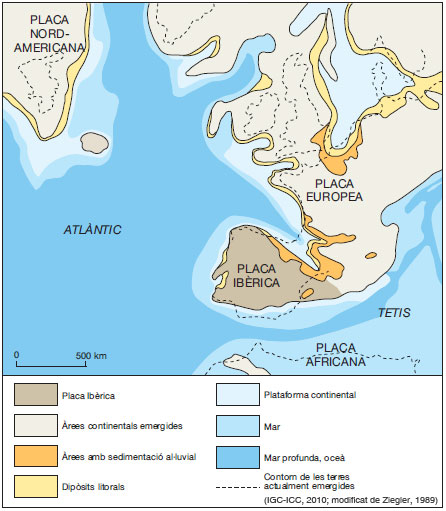At the end of the Cretaceous and the beginning of the Paleogene, the general situation had evolved rapidly. The convergence process between the Iberian Plate and the European Plate had lead to the collision of both plates. The greater part of the Iberian Plate, including Corsica and Sardinia, which were in the area that at present is occupied by the Gulf of Valencia and the Gulf of Lion, was emerged and subjected to intensive erosion. The ancient connection between the Tethys Ocean and the Bay of Biscay throughout the Pyrenean area was interrupted by the emergence of the eastern area (figure 10).
A great part of those recently emerged areas were lowlands and, close the northern Iberian edge, they were covered by vast alluvial plains through which braided rivers flowed transporting the clastic sediments from the erosion of the interior of the Iberian Plate. In those lowlands, there were also marshes and shallow lakes where peat and carbonates were deposited. Some of the latest dinosaurs that populated the Earth roamed through these marshy areas. The collection of these sediments is called Garumnian facies and there the limit between the Mesozoic and the Cenozoic is located. This limit is marked by the extinction of 75% of the terrestrial and marine species.
During the Paleocene, the environmental conditions were very similar to those of the late Cretaceous, with a predominance of continental sedimentation, alluvial or lacustrine. 55 Ma ago, in the early Eocene, the sea started to invade the lowlands. In the Pyrenean area, the progressive tectonic stacking of material from the basement and from the old sedimentary basins, which were produced by the effect of the collision between the Iberian and European plates, placeed an enormous load on its edges. The continuous increase in the load had caused the lithosphere, in the areas adjacent to the mountain ranges in formation, to flex towards that mountain range. As a consequence of this, some topographically depressed areas were generated on either side of the mountain range, and parallel to it, called foreland basins, which were immediately invaded by the sea. A good part of the Pyrenean area, of the Ebro Massif and the actual Coastal Range became shallow marine platforms where predominantly carbonate sediments were deposited. The typical foraminifera of this epoch are the alveolines, whose shells accumulated forming coastal sandbanks and bars due to the action of waves and tides. In the estuaries of the fluvial courses that drained the emerged areas, deltaic systems were formed which were also, to a lesser or greater degree, reworked by the tides.
As a consequence of the collision process between the Iberian Plate and the European Plate, fold and thrust sheet systems were formed in the Pyrenean area which inverted and exhumed the old sedimentary basins. These systems were tectonically displaced towards the south on the Iberian side. The collision process between the Iberian Plate and the European Plate would have reached its culmination towards the late Eocene and early Oligocene, approximately between 35 and 30 Ma.
In parallel with the formation of the Pyrenees, during the Eocene and Oligocene, the deformation that took place on the edge of the Iberian Plate was transmitted to the interior, in such a way that certain areas of intraplate, which had previously been subjected to extension during the Triassic, the Jurassic and early Cretaceous were deformed in a compressive context. This gave place to the formation of the Iberian Range and the Catalan Coastal Range. Specifically, in this latter area, the deformation was translated into the formation of reversed faults, thrusts and fault systems with horizontal anticlockwise displacement, which were oblique to the direction of maximum contraction of the Pyrenean area.
The result of all these events was that the area surrounded by the Pyrenees, the Iberian Range and the Catalan Coastal Range, the old Ebro Massif, disappeared as an emerged area which supplied sediments and became the basement of the foreland basin generated at the south of the Pyrenean area, the Ebro Basin, receiver of the sediments from the erosion of the reliefs that were being formed and that had started to emerge, both to the north and on its south east and south west boundaries.

 Contact
Contact







